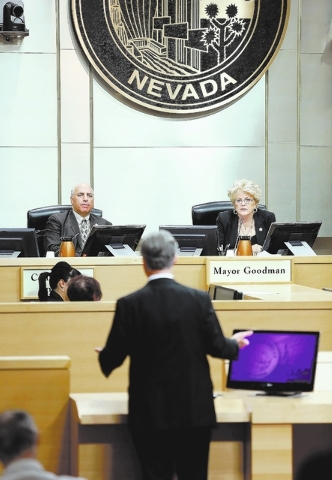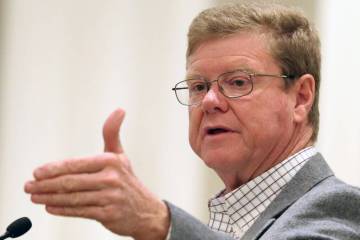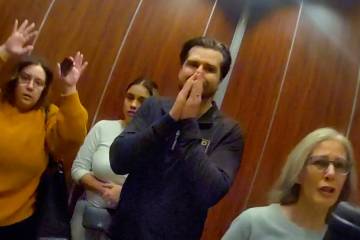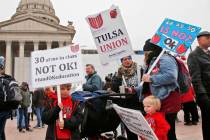Las Vegas council opposes giving nuclear waste project new life
As they’ve done in the past when the Yucca Mountain Project received billions of federal dollars for studying where to put the nation’s highly radioactive waste, Las Vegas City Council members chimed in Wednesday against resurrecting the funding-starved effort after a presentation by the state’s leading critic.
“It’s imperative if this gets shoved down our throat that the Department of Energy does something” to provide local governments with funding to train first responders, Councilman Steve Ross said.
Councilman Bob Coffin said that Southern Nevada’s population has roughly doubled since the state was intensely focused on fighting the Yucca Mountain Project 15 years ago. About half the people who live here don’t have the institutional memory of what has been at stake either with the federal nuclear waste effort or the legacy from above-ground nuclear testing at what was called the Nevada Test Site in the 1950s, he said.
“They weren’t here during the coverup in the mistakes in the geologic studies. They don’t understand what the fuss is about,” Coffin said about the Yucca Mountain fight.
He went on to reflect on the days of above-ground tests and the false sense of security and safety projected by federal officials behind nuclear weapons testing. He recalled seeing “a sickening white cloud moving in front of your face like a windshield wiper.”
“We fight these things from a historical perspective,” he said, adding, “It all boils down to a lack of faith.”
The comments followed a presentation by Nevada Nuclear Projects Agency chief Bob Halstead, the lead opponent tracking the project and nuclear waste issues at the Nevada National Security Site. He briefed the council on what to expect in Congress and from the Department of Energy following last month’s federal appeals court ruling that compels the Nuclear Regulatory Commission to restart the licensing process.
Halstead reminded the council that, in his words, “Nevada has been lied to non-stop by federal nuclear officials” when it comes to finding a safe and suitable site for entombing 77,000 tons of used fuel from power reactors and high-level nuclear defense waste.
“Yucca Mountain is unsafe, and (DOE’s) transportation plan is unsafe,” Halstead said.
He was referring to the volcanic rock ridge 100 miles northwest of Las Vegas that state officials contend is riddled with flaws not the least of which are porous features that would channel surface water downward and corrode metal waste containers, allowing radioactive materials to escape into the environment.
Equally alarming is the plan for hauling waste to the site by rail and trucks that would pass through the heart of Las Vegas, he said. An accident or terrorist attack could unleash deadly remnants of the nuclear power cycle, costing $10 billion to $100 billion to clean up by the state’s estimate, not a few tens of thousands of dollars to $10 billion as DOE estimates.
“It will kill you with a lethal dose of radioactivity and not just give you cancer 30 years down the road,” Halstead said.
For $25 billion, or about one-quarter the life-cycle cost of building a Yucca Mountain repository and hauling waste to it, he said, DOE could find a willing state with salt or shale formations to bury the waste. “So now there’s a business case as well as a safety case” for not going forward with licensing the Yucca Mountain site, he said.
Halstead said the state is grappling with the specter of DOE disposing of uranium-tainted nuclear power legacy waste in a shallow landfill at the Nevada National Security Site.
The waste stems from a 1960s nuclear power operation in New York state. DOE’s predecessor agency took possession of it after it was reprocessed, and its liquid residuals were sent to Oak Ridge National Laboratory to be solidified and baked inside 403 steel canisters with compounds to stop neutrons from triggering atom-splitting reactions.
“DOE wants us to believe that it is safer for shipments to go through the Spaghetti Bowl than up (state Route) 160,” Halstead said. “Frankly, I’m very strongly inclined to recommend legal action” to force DOE to re-do the transportation risk assessments so that agency officials can’t come back at a future date and say the state didn’t challenge them.
Mayor Carolyn Goodman described DOE’s decision to bring to Nevada this waste, which it considers to be low-level, as “terribly concerning.”
Contact reporter Keith Rogers at krogers@reviewjournal.com or 702-383-0308.






















